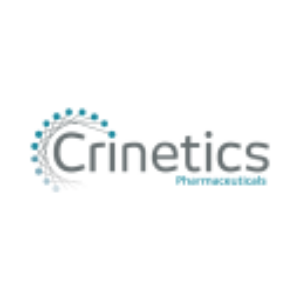Crinetics to Present New Research on Paltusotine, Atumelnant and Unmet Needs in Acromegaly Treatment at the American Association of Clinical Endocrinology Annual Meeting 2025
Rhea-AI Summary
Positive
- None.
Negative
- None.
New Analysis Shows Treatment with Investigational Paltusotine Resulted in Rapid and Durable IGF-1 Control in Surgically Naïve Acromegaly Patients
Additional Research Includes Acromegaly Symptom Burden and Standard-of-Care Discontinuation Rates
SAN DIEGO, May 15, 2025 (GLOBE NEWSWIRE) -- Crinetics Pharmaceuticals, Inc. (Nasdaq: CRNX) today announced it will present two abstracts at the American Association of Clinical Endocrinology (AACE) Annual Meeting 2025, taking place May 15–17 in Orlando, FL. One presentation is a post-hoc analysis showing investigational candidate paltusotine provided rapid and durable treatment effects and was well tolerated in surgically naïve patients with acromegaly. The second presentation on symptom variability in acromegaly shows the significant disease burden that patients on long-acting injectable somatostatin analogs can experience.
Additionally, one other acromegaly abstract – a real-world evidence analysis revealing high discontinuation rates with the existing standard-of-care treatment – and one abstract on investigational candidate atumelnant will be included in an AACE supplemental journal publication following the meeting. The atumelnant abstract features new data from a Phase 1b/2a study that provides insights into hydrocortisone administration and cortisol monitoring in patients with adrenocorticotropic hormone (ACTH)-dependent Cushing’s syndrome.
“We believe our lead development candidate, paltusotine, has the potential to deliver meaningful improvements for people living with acromegaly, and are encouraged by recent progress in both the U.S. and EU where regulatory reviews of its proposed use remain on track,” said Dana Pizzuti, M.D., Chief Medical and Development Officer, Crinetics. “As we prepare for a PDUFA action date of September 25 in the U.S., the research we’re presenting and publishing at AACE this year reinforces the potential for this novel, once-daily oral medicine, if approved, to advance the standard of care for people living with acromegaly.”
In addition to scientific presentations and publications, Crinetics is also sponsoring a Product Theater titled “Navigating the Complexities & Challenges of Acromegaly Management” featuring expert insights from: Dr. Elena Christofides, Chief Executive Officer, Endocrinology Associates, Inc.; Dr. Leena Shahla, Medical Director, Duke University School of Medicine; and Dr. Alan Krasner, Chief Endocrinologist, Crinetics.
Crinetics e-Poster Presentations and Online Publications at AACE 2025
Title: Paltusotine in the Treatment of Surgically Naïve Patients with Acromegaly: Post Hoc Analysis of Three Clinical Trials
Authors: Manoel Martins, MD, PhD et al.
E-Poster Date/Time: May 17, 12:50-1:05 PM ET
Location: Poster Station 15 – Learning Zone
Post-hoc analysis from three clinical trials (PATHFNDR-1 [PF1], PATHFNDR-2 [PF2], and ACROBAT Advance) showed that paltusotine provided rapid and sustained insulin-like growth factor 1 (IGF-1) control in surgically naïve patients, including those who were biochemically uncontrolled at baseline. Three of four patients in PF1 and all four patients in PF2 achieved IGF-1 normalization. In Phase 3 trials patients reached IGF-1 ≤1.0x ULN, and median IGF-1 remained stable over 24 months in ACROBAT Advance. Results suggest that paltusotine may be a viable first-line medical therapy for patients for whom surgery is not an option or preference.
Title: Quantitative Burden and Life Impact of Symptom Exacerbations in Patients with Medically Treated Acromegaly
Authors: Eliza B. Geer, MD et al.
E-Poster Date/Time: May 17, 12:50-1:05 PM ET
Location: Poster Station 9 – Learning Zone
In a three-month daily symptom diary study, patients receiving the long-acting injected depot somatostatin receptor ligands octreotide and lanreotide reported symptom exacerbations on
Title: Real-world Treatment Patterns in Acromegaly
Authors: Tiffany Quock, PhD, MS et al.
Online publication in Endocrine Practice supplement following the annual meeting
A retrospective analysis using IQVIA PharMetrics® Plus data found that
Title: Need to Pause Hydrocortisone? Physiologic Replacement Does Not Affect AM Serum Cortisol, Bedtime Salivary Cortisol or UFC in Cushing Syndrome Patients on Block and Replace Treatment
Authors: Henrik Elenius, MD et al.
Online publication in Endocrine Practice supplement following the annual meeting
Data from a Phase 2a study of atumelnant in patients with ACTH-dependent Cushing syndrome showed that physiologic hydrocortisone doses given before 5 p.m. did not impact morning or bedtime urinary free cortisol levels. These findings support continued use of hydrocortisone during monitoring, simplifying disease management for patients.
Crinetics-Sponsored Product Theater
Title: Navigating the Complexities & Challenges of Acromegaly Management
Date/Time: Thursday, May 15 | 7:00-7:45 AM ET
The poster presentations will be made available on the Crinetics website at the time of presentation in accordance with the AACE embargo policy.
About Paltusotine
Crinetics’ lead development candidate, paltusotine, is the first investigational once-daily, oral, selectively-targeted somatostatin receptor type 2 (SST2) nonpeptide agonist that has completed Phase 3 clinical development for acromegaly and is in Phase 3 clinical development for carcinoid syndrome associated with neuroendocrine tumors. It was designed to be a once-daily oral option for the control of acromegaly and carcinoid syndrome. In Phase 3 studies, once-daily, oral paltusotine maintained IGF-1 levels and symptom control in patients with acromegaly who were switched from monthly injectable medications (PATHFNDR-1) and rapidly decreased IGF-1 levels and symptom burden in medically untreated acromegaly patients (PATHFNDR-2). IGF-1 is the primary biomarker endocrinologists use to manage acromegaly patients. Results from a Phase 2 study in carcinoid syndrome demonstrated rapid and sustained reductions in flushing episodes and bowel movement frequency, which are the most common symptoms of carcinoid syndrome, leading to the initiation of a Phase 3 trial for control of carcinoid syndrome in patients with neuroendocrine tumors.
About Atumelnant
Atumelnant, Crinetics’ second investigational compound, is the first once-daily, oral adrenocorticotropic hormone (ACTH) receptor antagonist that acts selectively at the melanocortin type 2 receptor (MC2R) on the adrenal gland. Diseases associated with excess ACTH can have significant impact on physical and mental health. Atumelnant has exhibited strong binding affinity for MC2R in preclinical models and has demonstrated suppression of adrenally derived glucocorticoids and androgens that are under the control of ACTH. Data from a 12-week Phase 2 study demonstrated compelling treatment benefits of atumelnant, evidenced by the rapid, substantial and sustained statistically significant reductions in key CAH disease related biomarkers, including androstenedione and 17-hydroxyprogesterone, in a diverse population. Atumelnant is currently in development for congenital adrenal hyperplasia and ACTH-dependent Cushing’s syndrome.
About Crinetics Pharmaceuticals
Crinetics Pharmaceuticals is a clinical stage pharmaceutical company focused on the discovery, development, and commercialization of novel therapeutics for endocrine diseases and endocrine-related tumors. Crinetics’ lead development candidate, paltusotine, is the first investigational once-daily, oral, selective somatostatin receptor type 2 (SST2) nonpeptide agonist that is in clinical development for acromegaly and carcinoid syndrome associated with neuroendocrine tumors. Atumelnant is currently in development for congenital adrenal hyperplasia and ACTH-dependent Cushing’s syndrome. All of the company’s drug candidates are orally delivered, small molecule, new chemical entities resulting from in-house drug discovery efforts, including additional discovery programs addressing a variety of endocrine conditions such as hyperparathyroidism, polycystic kidney disease, Graves’ disease (including thyroid eye disease), diabetes, obesity and GPCR-targeted oncology indications.
Forward-Looking Statements
This press release contains forward-looking statements within the meaning of Section 27A of the Securities Act of 1933, as amended, and Section 21E of the Securities Exchange Act of 1934, as amended. All statements other than statements of historical facts contained in this press release are forward-looking statements, including statements regarding the plans and timelines for the clinical development of atumelnant and paltusotine, including the therapeutic potential and clinical benefits or safety profile thereof; the expected timing of the PDUFA target action date for our NDA submission to the FDA and of a potential EMA decision for our MAA for paltusotine for the treatment or maintenance of treatment of acromegaly in the United States and other applicable jurisdictions, and the plans and timelines for the commercial launch paltusotine if approved; and the therapeutic potential for our development candidates. In some cases, you can identify forward-looking statements by terms such as “may,” “will,” “should,” “expect,” “plan,” “anticipate,” “could,” “intend,” “target,” “project,” “contemplates,” “believes,” “estimates,” “predicts,” “potential,” “upcoming” or “continue” or the negative of these terms or other similar expressions. These forward-looking statements speak only as of the date of this press release and are subject to a number of risks, uncertainties and assumptions, including, without limitation, initial or topline data that we report may change following completion or a more comprehensive review of the data related to the clinical studies and such data may not accurately reflect the complete results of a clinical study, and the FDA and other regulatory authorities may not agree with our interpretation of such results; geopolitical events may disrupt Crinetics’ business and that of the third parties on which it depends, including delaying or otherwise disrupting its clinical studies and preclinical studies, manufacturing and supply chain, or impairing employee productivity; the success of Crinetics’ clinical studies and nonclinical studies; regulatory developments in the United States and foreign countries; clinical studies and preclinical studies may not proceed at the time or in the manner expected, or at all; the timing and outcome of research, development and regulatory review is uncertain, and Crinetics’ drug candidates may not advance in development or be approved for marketing; and the other risks and uncertainties described in the Company’s periodic filings with the Securities and Exchange Commission (SEC). The events and circumstances reflected in the company’s forward-looking statements may not be achieved or occur and actual results could differ materially from those projected in the forward-looking statements. Additional information on risks facing Crinetics can be found under the heading “Risk Factors” in Crinetics’ periodic filings with the SEC, including its annual report on Form 10-K for the year ended December 31, 2024 and quarterly report on Form 10-Q for the quarter ended March 31, 2025. You are cautioned not to place undue reliance on these forward-looking statements, which speak only as of the date hereof. Except as required by applicable law, Crinetics does not plan to publicly update or revise any forward-looking statements contained herein, whether as a result of any new information, future events, changed circumstances or otherwise.
Contact:
Media:
Natalie Badillo
Head of Corporate Communications
nbadillo@crinetics.com
(858) 345-6075
Investors:
Gayathri Diwakar
Head of Investor Relations
gdiwakar@crinetics.com
(858) 345-6340








